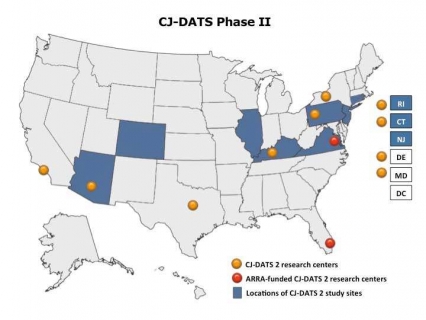Overview of the Criminal Justice Drug Abuse Treatment Studies (CJ-DATS) Phase I & II

CJ-DATS (the national Criminal Justice Drug Abuse Treatment Studies) was launched in 2002 and two initiatives (CJ-DATS-1 and CJ-DATS-2) were carried out from 2002 to 2014. The overarching goal of the CJ-DATS cooperative research programs was to improve both public health and public safety outcomes for substance abusing offenders leaving prison or jail and returning to the community by integrating substance abuse treatment into the criminal justice system. At that time CJ-DATS-1 was launched, an estimated 600,000 inmates were released each year in the United States, with approximately two-thirds having substance abuse problems that, if left unaddressed, could increase the risk of relapse and recidivism to crime.
CJ-DATS was designed to identify ways in which these offenders could benefit from the continuum of effective substance abuse treatment services. CJ-DATS tested several strategies for improving drug abuse treatment services through the coordination with criminal justice assessment, monitoring, and supervision activities. Further, the CJ-DATS initiatives were designed to inform the development of models for integrating evidence based substance abuse treatment with the criminal justice system.
CJ-DATS Phase I
From 2002 through 2008, CJ-DATS-1 researchers from 9 research centers, a coordinating center, and NIDA worked together with federal, state, and local criminal justice partners to develop and test integrated approaches to the treatment of offenders with drug use disorders.
CJ-DATS-I Studies
- Assessing Offender Problems
Inmate Pre-Release Assessment (IPASS)
PI: Michael Prendergast, Ph.D. (U01DA016211)
Although at least two valid assessments previously existed to inform decisions regarding level of supervision for paroling offenders (e.g., Level of Services Inventory) or modality of treatment for substance abusers in the community (e.g., ASAM criteria), neither of these assessments was developed specifically for substance-abusing parolees who are encouraged or required to participate in treatment after they are released from prison. IPASS was developed specifically as a post-release risk measure for prison-based substance abuse treatment graduates by taking into account the inmates’ historical drug use and criminal activity as well as his or her performance during the prison-based treatment program.
The primary purpose of this study was to:
- Test the ability of the IPASS to predict relapse and recidivism using a prospective design.
- Assess its use in matching offenders to a particular level of aftercare
Criminal Justice Co-Occurring Disorder Screening Instrument (CJ-CODSI)
PI: Stanley Sacks, Ph.D. (RC2DA028967)
An understanding of the presence and extent of co-occurring disorders (co-existing substance use and mental disorders, of COD) is essential to improving the design of COD programming, both in prison and upon release. The measures currently employed in criminal justice programs, particularly those developed to screen for mental health disorder, typically focus on mental disorders or substance abuse disorders separately, and fail to examine the extent to which these disorders co-exist in the criminal justice population.
This 12-month research project aimed to:
- Develop a brief screening instrument that identifies individuals with COD in 20 minutes or less and that could be self-administered or administered by staff who do not have mental health training.
- Assess the feasibility of using the instrument to determine rates of COD in the offender population by conducting a study of 300 consecutive admissions to prison-based substance abuse treatment programs at selected sites.
- Measuring Progress in Treatment and Recovery
Performance Indicators for Corrections (PIC)
PI: Kevin Knight, Ph.D. (U01DA016190)
Given the limited ability of treatment for offenders with substance abuse problems, correctional systems need to optimize the benefits from their treatment programs and determine which components are having the greatest impact on psychological, cognitive, and behavioral change. Assessments can help correctional systems monitor and document client changes during treatment, providing the foundations for meeting needs in evaluating and managing services.
This study evaluated the TCU Criminal Justice Client Evaluation of Self and Treatment (CJ-CEST) and NDRI Client Assessment Inventory (CAI) with regard to methodological issues around:
- Client functioning and treatment engagement
- Client responses to treatment interventions;
- Strategies for monitoring needs and performance over time, and program functioning and organizational change.
- Linking Criminal Justice and Drug Abuse
-
Targeted Interventions for Corrections (TIC)
PI: Dwayne Simpson, Ph.D. (R37DA013093)
Community-based re-entry treatment programs for correctional populations often are not integrated into using an overall "continuing-care" strategy and are not managed or monitored according to procedures designed to help guide or maximize their effectiveness. The objective for this study was to establish guidelines and resources for an evidence-based library of targeted treatment intervention components for outpatient (i.e., moderate severity) re-entry correctional programs. These materials were drawn primarily from existing drug treatment resources, especially those previously developed by CJ-DATS Research Centers. The TCU Treatment Model provides conceptual and scientific foundations for the use of targeted interventions that address client problems related to treatment readiness and motivation, anger and hostility, criminal thinking, risky behaviors for HIV/AIDS/Hepatitis C, communication, and other social skill deficits.
Specific aims were to establish a set of targeted interventions that:- Address counseling needs in community re-entry treatment programs.
- Meet "evidence-based" standards of effectiveness for correctional populations.
- Represent brief, flexible, and focused treatment tools, and are judged and adopted as user-friendly and manual-guided applications.
Transitional Case Management (TCM)
PI: Michael Prendergast, Ph.D. (R01DA013114)
A major obstacle to the effectiveness of post-prison treatment for substance-abusing offenders is low treatment engagement: the failure of parolees to show up for scheduled treatment and, if they do show up, their tendency to drop out early. This is particularly a problem where participation in treatment by parolees is voluntary, where incentives (pressures) to enter and remain in treatment are usually minimal. The Transitional Case Management study tested whether case management taking place during a prison inmate’s transition from prison to the community increases participation in community drug abuse treatment, enhances access to needed social services, and improves outcomes.
The specific aims were to:- Assess whether the TCM intervention increases the likelihood that parolees leaving prison treatment enter and successfully complete treatment, gain access to needed services, and reduce drug relapse and recidivism.
- Determine whether the TCM intervention increases the likelihood that treatment, criminal justice, and community services agency staff improve their patterns of communication and collaboration in dealing with substance-abusing parolees.
- Assess whether the TCM intervention is more cost effective than standard referral processes.
Step’n Out
PI: Peter Friedman, M.D. (U01DA016191)
The parole and outpatient addiction treatment systems have limited collaboration and communication, which may lead to a multitude of behavioral expectations with variable reinforcement. Research supports that behavioral outcomes are optimized when behavioral expectations are few in number, clear, and consistently reinforced. Step’n Out examined whether improved integration between the parole and outpatient addiction treatment systems improved treatment adherence, drug use, and public safety outcomes among drug-involved parolees.
The specific aims of Step’n Out were:
- Systematize collaborative assessment, treatment orientation, planning, and monitoring between parole officers, treatment counselors and clients.
- Encourage therapeutic relationships and lasting behavioral change through a coordinated, supportive approach to supervision that emphasizes the client’s pro-social goals and positive responses to their attainment.
- HIV and Hepatitis Risk Reduction
HIV Prevention for Drug-Involved Offenders During Reentry (HIV Prevention)
PI: James Inciardi, Ph.D. (R37DA006124)
HIV Prevention for Drug-Involved Offenders During Reentry was designed to address the prevalence of HIV/HCV/HBV within the community corrections offender population. The study examined the effectiveness of a HIV/HCV/HBV intervention protocol and was designed to learn how it is integrated into community corrections. The approach was a multi-media prevention intervention utilizing an interactive DVD and workbook tailored to specific gender and ethnic groups and risk behaviors.
Specific study aims included:
- Collecting HIV, HCV and HBV risk behavior information.
- Implement and evaluate the effectiveness of a newly refined HIV/HCV/HBV prevention/intervention protocol (the CJ Targeted Intervention).
- Determine the relative effectiveness of the interventions when delivered by a certified HIV peer interventionist counselor.
- Integrate HIV/HCV/HBV prevention into the post-release community supervision process.
- Examine how intervention delivery is affected by different organizational structures and orientations.
Restructuring Risky Relationships-HIV (RRR-HIV)
PI: Carl Leukefeld, Ph.D. (R01DA011580)
This project examined a HIV intervention addressing women’s HIV risks. The overall goal of this project was to develop an HIV intervention for criminal justice involved female drug abusers who are re-entering the community. The intervention focused on reducing HIV behaviors by restructuring relationship thinking errors to help women make safer decisions about risky HIV related behaviors.
The following specific aims organized the project:- Develop the RRR-HIV intervention manual which incorporates relationships, thinking errors, and HIV related risky behaviors.
- Pilot the RRR-HIV intervention to examine the content and feasibility of delivery.
- Evaluate the intervention manual using an experimental two group design
- Adolescent Interventions
A Comparison of Two Reentry Strategies for Drug Abusing Juvenile Offenders (Reentry)
PI: Nancy Jainchill, Ph.D. (U01DA016201)
The Two Reentry Strategies study responds to the critical need to implement, evaluate, and identify effective reentry programs for adolescents with substance use problems involved in the juvenile justice system. The study involved two phases.
Phase 1 was a short-term project involving a cross sectional assessment of drug-involved youths receiving treatment in justice system residential facilities. Its purpose was to classify juveniles based on whether their substance use was a primary problem or was secondary to other problems such as psychiatric disorders, criminal involvement, or experience of physical, sexual, or psychological trauma.
Phase 2 was a longer-term study comparing two reentry protocols: Cognitive Restructuring (CR), and alternative aftercare services (AAS) in regard to post-reentry treatment outcomes. This study examined interactions of these programs with the youth profiles identified in Phase 1.
Detention To Community (DTC): A Family-Based Substance Abuse, Delinquency and HIV Prevention Intervention for Juvenile Offenders
PI: Howard Liddle, Ph.D. (R01DA015995)
Drug abuse and related risk behaviors by young offenders are among the nation’s most urgent public health priorities. While there have been important advances in the development of specialized treatments for the constellation of risk behaviors associated with teen drug abuse in the past decade, little progress has been made in addressing the overwhelming problem of drug abuse and related risk behaviors among juvenile detainees.
Specific aims for this study included:
- Adapting existing science-based interventions to develop specialized services that will address drug abuse, delinquency, and sexual risk taking among juvenile detainees.
- Testing an innovative, phasic, multiple-systems intervention in which the in-detention work provides a platform for the adolescent’s return to the community.
- Testing a family-based HIV/AIDS prevention intervention in comparison to standard HIV prevention.
- Understanding Systems
National Criminal Justice Treatment Practices Survey (Treatment)
PI: Faye Taxman, Ph.D. (U01DA016213)
The National Criminal Justice Treatment Practices Survey provided estimates of the prevalence of certain treatment delivery practices within the criminal justice system and expanded our understanding of the organizational and structural issues that influence practice. The survey provides a platform for the development of a new generation of research regarding systems issues by identifying general trends in the delivery of services and the influencing factors.
The primary purposes of this study were to:
- Describe current drug treatment practices and delivery systems for offenders including the policies, philosophy, resources, and organizational structure of the delivery systems.
- Develop a common set of organizational and system measures of drug treatment practices in correctional settings, including system integration measures.
- Understand the role of organizational factors and dynamics in the drug treatment practices and systems integration within the research cooperative and nationally.
COD Survey: National Criminal Justice Treatment Practices (NCJTP) Survey Of Co-occurring Substance Use and Mental Disorders (COD) Treatment Facilities in Criminal Justice Settings
PI: Gerald Melnick, Ph.D. (R01DA015264)
The COD Survey extended the NCJTP with the goal of increasing knowledge about the service delivery and organizational practices for offenders with co-occurring disorders in the criminal justice system. The sample included wardens/directors of prisons and jails; administrators in charge for probation and parole offices; and directors of outpatient substance abuse treatment programs that treat criminal justice clients (a total of 1046 adult and juvenile facilities) previously included in the NCJTP.
The goals of the study were to:
- Describe the services available to offenders evincing co-occurring substance use and mental disorders.
- Depict the organizational practices of the agencies that provide services to offenders with co-occurring disorders.
- Explain the relationship between organizational practices and the provision of services for offenders with co-occurring disorders.
eCourt
PI: Faye Taxman, Ph.D. (R01DA010705)
The e-Court project was intended to address practical needs involving monitoring and reporting on drug courts nationally while also building basic knowledge on technology transfer and the role of technology in advancing program implementation and effectiveness.
Specific aims included:
- Develop and test a management information system (MIS) for monitoring performance at the individual (client) and program level that can be readily adopted and implemented in drug courts receiving federal funding. The system was designed to record and facilitate case management activities of line staff, generate reports the court can use to monitor progress and inform development, and provide data needed for the federal Office of Justice Programs to describe court practices and assess performance.
- Assess how drug courts used web-based technology and examine the role of various organizational factors in the adoption and effective use of a web-based MIS developed for the drug court setting.
- Investigate the actual and potential impacts of information technology on drug court performance in the areas of case management, client compliance with treatment and supervision mandates, integration of justice and service systems, and the provision of effective treatment to drug court clients.
Research Centers
- CJ-DATS-I Research Centers
Research Center PI Co-PIs National Institute on Drug Abuse (NIDA) Bethesda, MD Bennett Fletcher, Ph.D. Sarah Q. Duffy, Ph.D. CJ-DATS Coordinating Center
George Mason University
Fairfax, VA
U01DA016213Faye S. Taxman, Ph.D. Douglas Young, MS Central States Research Center
Center for Drug and Alcohol Research, University of Kentucky
Lexington, KY
U01DA016205Carl G. Leukefeld, DSW Lon Has, M.D., MBA
TK Logan, Ph.D.
Catherine Martin, Ph.D.
Carrie Oser, Ph.D.
Michele Staton-Tindall, Ph.D.
D.J. Matthew Webster, Ph.D.
Conrad Wong, Ph.D.Connecticut Research Center
Connecticut Department of Mental Health and Addiction Services
Hartford, CT
U01DA016194Linda K. Frisman, Ph.D. Mark Litt, Ph.D.
Nancy Covell, Ph.D.
Susan Pease, Ph.D.
Gail Sturges, LCSW, J.D.Florida Research Center
Center for Treatment Research on Adolescent Drug Abuse (CTRADA)
Leonard M. Miller School of Medicine
University of Miami
Miami, FL
U01DA016193Howard Liddle, EdD Cindy Rowe, Ph.D.
Clyde McCoy, Ph.D.
Gayle Dakof, Ph.D.
Craig Henderson, Ph.D.Mid-Atlantic Research Center
Center for Drug and Alcohol Studies (CDAS) University of Delaware
Newark, DE
U01DA016230James A. Inciardi, Ph.D. Clifford A. Butzin, Ph.D.
Lana Harrison, Ph.D.
Steven S. Martin, Ph.D.
Hilary L. Surratt, Ph.D.Midwest Research Center
Center for Therapeutic Community Research
National Development and Research Institutes, Inc. (NDRI)
New York, NY
U01DA016201Nancy Jainchill, Ph.D. Richard Dembo, Ph.D. Pacific Coast Research Center
Integrated Substance Abuse Programs (ISAP)
University of California, Los Angeles
Los Angeles, CA
U01DA016211Michael L. Prendergast, Ph.D. David Farabee, Ph.D.
Christine Grella, Ph.D.Rhode Island Research Center
Substance Abuse Research Unit
Brown University Medical School
Lifespan Hospital
Providence, RI
U01DA016191Peter D. Friedmann, M.D., MPH Jennifer Clarke, M.D.
Lynda Stein, Ph.D.
Timothy Flanigan, M.D.
Josiah D. Rich, M.D., MPH
Michael Stein, M.D.
Caron Zlotnick, Ph.D.Rocky Mountains Research Center
Center for Integration of Research and Practice
National Development and Research Institutes, Inc. (NDRI)
New York, NY
U01DA016200Harry K. Wexler, Ph.D. Gerald Melnick, Ph.D.
Stanley Sacks, Ph.D.
JoAnn Sacks, Ph.D.Southwest Research Center
Institute of Behavioral Research (IBR) Texas Christian University
Fort Worth, TX
U01DA016190Kevin Knight, Ph.D. Dwayne D. Simpson, Ph.D.
Patrick M. Flynn, Ph.D.
CJ-DATS Phase II
The second phase of CJ-DATS, engaging a new cohort of research centers and agency partners, was launched in 2008 with a focus on conducting implementation research in these criminal settings. Specifically, NIDA charged the cooperative with testing implementation strategies that could result in sustained uptake and delivery of services in three domains: (1) delivery of medication-assisted treatment for offenders transitioning to the community; (2) delivery of an HIV continuum of care (i.e., screening and counseling, risk reduction interventions, and continuity of antiretroviral treatment from prison or jail into the community); and (3) implementation of screening and assessment processes to identify offenders with drug abuse and related health problems and to inform their treatment planning and re-entry process.
In each domain, grantees were to focus on organizational and system-level implementation strategies, and to engage both community corrections and community-based treatment providers in a process that would leverage key facilitators, address barriers, and jointly address the public safety concerns of criminal justice agencies with the public health goals of the Institute and the community-based treatment partners. NIDA’s ultimate goal for CJ-DATS is to identify implementation strategies that maximize the likelihood of sustained delivery of evidence-based practices to improve offender drug abuse and HIV outcomes, and to decrease their risk of incarceration.
CJ-DATS-II Studies
- View Studies
Medication-Assisted Treatment Implementation in Community Correctional Environments (MATICCE)
The MATICCE protocol focuses on implementing linkages to medication-assisted treatment in correctional settings. The US Food and Drug Administration (FDA) has approved medications for use in the treatment of alcohol and opiate dependence. Unlike much of the healthcare system, in which new medications are routinely introduced and adopted, the US addiction treatment system has been slow to adopt pharmacotherapies, lacks trained and credentialed personnel to deliver them, and evidences a longstanding philosophical preference for “drug free” treatment. These constraints and concerns are magnified in community corrections agencies, where the appropriate role of pharmacotherapy is not well understood, and the medically appropriate use of opioid agonists (e.g., methadone) may present challenges for monitoring offenders’ illicit drug use.
In the MATICCE study, community corrections staff engage in training about addiction pharmacotherapies, while leadership in the corrections and treatment facilities engage in a joint strategic planning process to identify and resolve barriers to efficient flow of clients across the two systems. Importantly, the objective is to leverage treatment services that already exist in the community. This means that the implementation strategy is not designed to promote the delivery of clinical services nor medication prescribing within or by probation and parole offices, but rather is targeted at facilitating linkages between organizations that, despite sharing the same clients, lack incentive to coordinate services, or otherwise do not view themselves as sharing a common mission.
HIV Services and Treatment Implementation in Corrections (HIV-STIC)
HIV-STIC focuses on implementing interventions to address the HIV continuum of care in correctional settings. Evidence-based approaches exist for HIV risk reduction, testing, and treatment with antiretroviral therapy. However, there are significant gaps in this service continuum for offenders in the criminal justice system. Services may or may not be provided while individuals are incarcerated; transitions to the community may introduce additional service disruptions; and individual offenders face challenges navigating their prevention, testing and treatment options.
The HIV-STIC study protocol tests a modified NIATx process to facilitate site-specific improvements in the HIV services continuum. In both control sites and sites randomized to the modified NIATx process, criminal justice staff receive training on the fundamentals of HIV prevention and treatment. Sites randomized to the experimental condition form a local change team to engage in a process improvement approach with external coaching to implement a more complete HIV services continuum. Within the overall parameters of the protocol – which emphasizes HIV testing and linkage to treatment – sites assess local needs and existing services, set priorities for service improvements, and develop specific goals and strategies for achieving them. All sites participating in the HIV-STIC study target three goals: (1) improving the perceived value of HIV services among corrections staff; (2) increasing service penetration for inmates with or at risk for HIV; and (3) improving the quality of HIV service delivery.
Assessment Organizational Process Improvement Intervention (OPII)
The Assessment OPII study focuses on implementing assessment and treatment planning processes. Screening and assessment are used to identify substance abuse-related problems and to develop programming to address the problems so identified. Conducting a valid and reliable assessment is considered an essential step in providing effective treatment services and in being able to prioritize treatment and services according to type and severity of need. While research has established that a number of screening and assessment instruments (e.g., ASI, GAIN, LSI-R) have adequate validity and reliability, there is far less research on the successful implementation of these assessment tools, or on how they should be used to improve the course and effectiveness of treatment.
Like the HIV-STIC protocol, the Assessment OPII study also uses a modified NIATx approach. In contrast to the HIV-STIC protocol, which focuses on promoting the uptake of specific services, the Assessment OPII study engages corrections and treatment agencies to improve the quality of interagency communication through the effective use of assessment and case planning processes and treatment referrals. Both interagency and intra-agency change processes are targeted. A multi-phase implementation protocol is used, wherein agencies engage in team development, needs assessment, planning, implementation, and sustainability in distinct steps. Each site’s change team has a designated facilitator, and their activities are coordinated across sites through the use of a facilitator manual and ongoing fidelity measurement. Early and delayed-start sites allow the research team to control for effects of environmental changes within states. The key outcomes for this protocol reflect improvements in the use of assessment and case planning procedures for offenders. Specifically, offenders should not only receive comprehensive assessments, but the results of these assessments should inform case plans, and the information in the case plan should be conveyed to the local treatment provider agency to which the offender is referred upon release. The protocol targets critical communications channels between otherwise highly segregated correctional and treatment agencies.
Research Centers
- CJ-DATS-II Research Centers
-
Research Center PI Co-PIs National Institute on Drug Abuse (NIDA)
Bethesda, MDBennett Fletcher, Ph.D.
Lori Ducharme, Ph.D.Sarah Q. Duffy, Ph.D.
Tisha Wiley, Ph.D.AMAR International, Inc.
Reston, VA
271200800031C-3-0-1Savita Prakash, Ph.D. Arizona Research Center
Phoenix, AZ
U01DA025307Michael S. Shafer, Ph.D. David Duffee, Ph.D.
Cassia Spohn, Ph.D.
Barbara BroderickDelaware Research Center
Newark, DE
U01DA016230Christy A. Visher, Ph.D. Steven S. Martin, MA, MSc.
Daniel O'Connell, Ph.D.
Lana Harrison, Ph.D.
Cynthia Robbins, Ph.D.
James Wojtowicz, MANDRI Research Center
New York, NY
U01DA016200Stanley Sacks, Ph.D. Frank S. Pearson, Ph.D.
Gerald Melnick, Ph.D.
Joan Shoemaker, RN, BSNFriends Research Institute Maryland Research Center
Baltimore, MD
U01DA025233Timothy W. Kinlock, Ph.D. Michael Gordon, D.P.A.
Robert Schwartz, M.D.Rhode Island Research Center
Kingston, RI
U01DA016191Peter Friedmann, M.D., MPH Lydia Stein, Ph.D.
Jennifer Clarke, M.D., MPHTexas Research Center
Fort Worth, TX
U01DA016190Kevin Knight, Ph.D. Dwayne Simpson, Ph.D.
Patrick Flynn, Ph.D.
Wayne Lehman, Ph.D.
Dona Howell, MS, CRADC/MISAIITemple Research Center
Philadelphia, PA
U01DA025284Steven Belenko, Ph.D. Wayne Welsh, Ph.D.
Matthew Hiller, Ph.D.
Gerald Stahler, Ph.D.
Jeremy Mennis, Ph.D.
Jennifer Wood, Ph.D.
David Zanis, Ph.D.
Ellen Tedaldi, M.D.
Roger Peters, Ph.D.
Richard Dembo, Ph.D.
Gary Zajac, Ph.D.Pacific Coast Research Center
Los Angeles, CA
U01DA016211Michael L. Prendergast, Ph.D. David Farabee, Ph.D.
William Burdon, Ph.D. Patricia Noble-Desy, M.A.Connecticut Research Center
Hartford, CT
U01DA016194Linda Frisman, Ph.D. Hsiu-Ju Lin, Ph.D.
Wendy Ulaszek, Ph.D.
Juliane Fenster, Ph.D.
Michael Copenhaver, Ph.D.
Frederick Altice, M.D.
Robert Trestman, Ph.D., M.D.
Amy James, Ph.D.
Daniel Bannish, Psy.D.Central States Research Center
Lexington, KY
U01DA016205Carl Leukefeld, Ph.D. Kimberly Potter-Blair
Resources
Bibliography
- Listing of publications from CJ-DATS I & II
-
2013
Recent publications from CJ-DATS-I & CJ-DATS-II can be found by searching for the RFAs that funded CJ-DATS on NIH's Project Reporter Site:
2012
Coffman DL, Kugler KC. (2012). Causal mediation of a human immunodeficiency virus preventive intervention. Nursing Research, 61(3), 224-230. [PubMed]
Friedmann PD, Green TC, Taxman FS, Harrington M, Rhodes AG, Katz E, O’Connell D, Martin SS, Frisman LK, Litt M, Burdon W, Clarke JG, Fletcher BW for the Step’n Out Research Group of CJ-DATS. (2012). Collaborative behavioral management among parolees: Drug use, crime & re-arrest in the Step’N Out randomized trial. Addiction, 107(6), 1099-1108. DOI [PubMed]
Harp KLH, Oser C, Leukefeld C. (2012). Social support and crack/cocaine use among incarcerated mothers and nonmothers. Substance Use & Misuse, 47(6), 686-694. DOI [PubMed]
2011
Johnson JE, Friedmann PD, Green TC, Harrington M, Taxman FS. (2011). Gender and treatment response in substance use treatment-mandated parolees. Journal of Substance Abuse Treatment, 40(3), 313-321. DOI [PubMed]
Staton-Tindall M, Frisman L, Lin HJ, Leukefeld C, Oser C, Havens JR, Prendergast M, Surratt,HL, Clarke J. (2011). Relationship influence and health risk behavior among re-entering women offenders. Womens Health Issues, 21(3): 230-238. DOI [PubMed]
Prendergast M, Frisman L, Sacks JY, Staton-Tindall M, Greenwell L, Lin HJ, Cartier J. (2011). A multi-site, randomized study of strengths-based case management with substance-abusing parolees. Journal of Experimental Criminology, 7(3), 225-253. DOI [PubMed]
2010
Henderson CE, Dakof GA, Greenbaum PE, Liddle HA. (2010). Effectiveness of Multidimensional Family Therapy with higher severity substance-abusing adolescents: report from two randomized controlled trials. Journal of Consulting and Clinical Psychology, 78(6), 885-897. DOI [PubMed]
2009
Chandler RK, Dennis ML, El-Bassel N, Schwartz RP, Field G. (2009). Ensuring safety, implementation and scientific integrity of clinical trials: lessons from the Criminal Justice–Drug Abuse Treatment Studies Data and Safety Monitoring Board. Journal of Experimental Criminology, 5(3), 323-344. [SpringerLink]
Fletcher BW, Lehman WEK, Wexler HK, Melnick G, Taxman FS, Young DW. (2009). Measuring collaboration and integration activities in criminal justice and substance abuse treatment agencies. Drug and Alcohol Dependence, 103(Suppl. 1), S54-S64. DOI [ScienceDirect]
Friedmann PD, Taxman FS, Rhodes AG, O’Connell DJ, Frisman LK, Burdon WM, Katz EC, Litt MD, Martin SS. (2009). The Step'n Out Study of collaborative behavioral management for drug-involved parolees. Substance Abuse, 30(1): 88-89. DOI
Friedmann PD, Rhodes AG, Taxman FS, for the Step’N Out Research Group of CJDATS. (2009). Collaborative behavioral management: Integration and intensification of parole and outpatient addiction treatment services in the Step'n Out Study. Journal of Experimental Criminology, 5(3), 227-244. DOI [PubMed]
Havens JR, Leukefeld CG, Oser CB, Staton-Tindall M, Knudsen HK, Mooney J, Duvall JL, Clarke JG, Frisman L, Surratt HL, Inciardi JA. (2009). Examination of an interventionist-led HIV intervention among criminal justice-involved female prisoners. Journal of Experimental Criminology, 5(3), 245-272. DOI [PubMed]
Henderson CE, Taxman FS. Competing values among criminal justice administrators: The importance of substance abuse treatment. Drug and Alcohol Dependence 2009:103(Suppl. 1), S7-S16. DOI [PubMed]
Henderson CE, Young DW, Farrell J, Taxman FS. (2009). Associations among state and local organizational contexts: Use of evidence-based practices in the criminal justice system. Drug and Alcohol Dependence, 103(Suppl. 1), S23-S32. DOI [PubMed]
Lehman WEK, Fletcher BW, Wexler HK, Melnick G. (2009). Organizational factors and collaboration and integration activities in criminal justice and drug abuse treatment agencies. Drug and Alcohol Dependence, 103(Suppl. 1), S65-S72. DOI [PubMed]
Marvel F, Rowe CL, Colon-Perez L, DiClemente RJ, Liddle HA. (2009). Multidimensional Family Therapy HIV/STD risk-reduction intervention: An integrative family-based model for drug-involved juvenile offenders. Family Process, 48(1), 69-84. DOI [PubMed]
Melnick G, Ulaszek WR, Lin HJ,Wexler HK. (2009). When goals diverge: Staff consensus and the organizational climate. Drug and Alcohol Dependence, 103(Suppl. 1), S17-S22. DOI [PubMed]
Oser C, Knudsen H, Staton-Tindall M, Leukefeld C. (2009). The adoption of wraparound services among substance abuse treatment organizations serving criminal offenders: The role of a women-specific program. Drug and Alcohol Dependence, 103(Suppl. 1), S82-S90. DOI [PubMed]
Prendergast M, Greenwell L, Cartier J, Sacks J, Frisman L, Rodis E, Havens JR. (2009). Adherence to scheduled sessions in a randomized field trial of case management: The Criminal Justice–Drug Abuse Treatment Studies Transitional Case Management study. Journal of Experimental Criminology, 5(3), 273-297. DOI [PubMed]
Sacks S, Cleland CM, Melnick G, Flynn PM, Knight K, Friedmann PD, Prendergast ML , Coen C. (2009). Violent offenses associated with co-occurring substance use and mental health problems: Evidence from CJDATS. Behavioral Sciences & the Law, 27(1), 51-69. DOI [PubMed]
Staton-Tindall M, Havens JR, Oser CB, Prendergast M, Leukefeld C. (2009). Gender-specific factors associated with community substance abuse treatment utilization among incarcerated substance users. International Journal of Offender Therapy and Comparative Criminology, 53(4), 401-419. DOI [PubMed]
Taxman FS, Friedmann PD. (2009). Fidelity and adherence at the transition point: Theoretically driven experiments. Journal of Experimental Criminology, 5(3), 219-226. [SpringerLink]
Taxman FS, Henderson CE, Belenko S. (2009). Organizational context, systems change, and adopting treatment delivery systems in the criminal justice system. Drug and Alcohol Dependence, 103(Suppl. 1), S1-S6. DOI [PubMed]
Taxman FS, Kitsantas P. (2009). Availability and capacity of substance abuse programs in correctional settings: A classification and regression tree analysis. Drug and Alcohol Dependence, 103(Suppl. 1), S43-S53. DOI [PubMed]
Young DW, Farrell JL, Henderson CE, Taxman FS. (2009). Filling service gaps: Providing intensive treatment services for offenders. Drug and Alcohol Dependence, 103(Suppl. 1), S33-S42. DOI [PubMed]
2008
Cartier JJ, Greenwell L, Prendergast ML (2008). The persistence of HIV risk behaviors among methamphetamine-using offenders. Journal of Psychoactive Drugs, 40(4), 437-446. [PubMed]
Duncan A, Sacks S, Melnick G, Cleland CM, Pearson FS, Coen C. (2008). Performance of the CJDATS Co-occurring Disorders Screening Instruments(CODSIs) among minority offenders. Behavioral Sciences & the Law, 26(4), 351-368. DOI [PubMed]
Friedmann PD, Katz EC, Rhodes AG, Taxman FS, O’Connell DJ, Frisman LK, Burdon WM, Fletcher BW, Litt MD, Clarke J, Martin SS. (2008). Collaborative behavioral management for drug-involved parolees: Rationale and design of the Step’n Out study. Journal of Offender Rehabilitation, 47(3), 290-318. DOI [PubMed]
Friedmann PD, Melnick G, Jiang L, Hamilton Z. (2008). Violent and disruptive behavior among drug-involved prisoners: Relationship with psychiatric symptoms. Behavioral Sciences & the Law, 26(4), 389-401. DOI [PubMed]
Frisman L, Prendergast ML, Lin HJ, Rodis E, Greenwell L. (2008). Applying Classification and Regression Tree analysis to identify prisoners with high HIV risk behaviors. Journal of Psychoactive Drugs, 40(4), 447-458. DOI [Routledge]
Grella CE, Greenwell L, Prendergast M, Sacks S, Melnick G. (2008). Diagnostic profiles of offenders in substance abuse treatment programs. Behavioral Sciences & the Law, 26(4), 369-388. DOI [PubMed]
Henderson CE, Taxman FS, Young DW. (2008). A Rasch model analysis of evidence-based treatment practices used in the criminal justice system. Drug and Alcohol Dependence, 93(1-2), 163-175. [PubMed]
Inciardi JA, Leukefeld CG, Martin SS, O’Connell DJ. (2008). HIV and other infectious diseases among drug-involved offenders: Introduction. Journal of Psychoactive Drugs, 40(4), 423-426. [PubMed]
Knudsen HK, Leukefeld C, Havens JR, Duvall JL, Oser CB, Staton-Tindall M, Mooney J, Clarke JG, Frisman F, Surratt HL, Inciardi JA. (2008). Partner relationships and HIV risk behaviors among women offenders. Journal of Psychoactive Drugs, 40(4), 471-481. [PubMed]
Martin SS, O'Connell DJ, Inciardi JA, Surratt HL, Maiden KM. (2008). Integrating an HIV/HCV brief intervention in prisoner reentry: Results of a multisite prospective study. Journal of Psychoactive Drugs, 40(4), 427-436. [PubMed]
Melnick G, Coen C, Taxman FS, Sacks S, Zinsser KM. (2008). Community-based co-occurring disorder (COD) intermediate and advanced treatment for offenders. Behavioral Sciences & the Law, 26(4), 457-473. DOI [PubMed]
Melnick G, Wexler HK, Cleland CM. (2008). Client consensus on beliefs about abstinence: Effects on substance abuse treatment outcomes. Drug and Alcohol Dependence, 93(1-2), 30-37. DOI [PubMed]
Oser CB, Havens JR, Mooney JL, Staton-Tindall M, Knudsen HK, Duvall JL, Leukefeld CG. (2008). Racial differences in HIV/AIDS discussion strategies and sexual risk behaviors among drug-abusing female criminal offenders. Journal of Psychoactive Drugs, 40(4), 483-492. [PubMed]
Oser C, Havens J, Staton-Tindall M, Wong C, Leukefeld C, Prendergast M. (2008). HIV sexual risk behaviors among ketamine and non-ketamine using criminal offenders prior to prison entry. Addiction Research & Theory, 16(3), 289-302. DOI [PubMed]
Pearson FS, Cleland CM, Chaple M, Hamilton Z, Prendergast ML, Rich JD. (2008). Substance use, mental health problems, and behavior at risk for HIV: Evidence from CJDATS. Journal of Psychoactive Drugs, 40(4), 459-469. DOI [Routledge]
Prendergast ML, Cartier J. (2008). Improving parolees’ participation in drug treatment and other services through strengths case management. Perspectives: Journal of the American Probation and Parole Association, 32(1), 38-46.
Rhodes AG, Taxman FS, Friedmann PD, Cropsey KL. (2008). HCV in incarcerated populations: An analysis of gender and criminality on risk. Journal of Psychoactive Drugs, 40(4), 493-501. DOI [Routledge]
Rowe CL, Wang W, Greenbaum P, Liddle HA. (2008). Predicting HIV/STD risk level and substance use disorders among incarcerated adolescents. Journal of Psychoactive Drugs, 40(4), 503-512. DOI [Routledge]
Sacks S, Melnick G, Grella CE. (2008). Introduction to this issue: Studies of co-occurring disorders in the criminal justice system. Behavioral Sciences & the Law, 26(4), 347-349. DOI [PubMed]
Sacks S, Melnick G, Grella CE. (2008). Synthesis of studies of co-occurring disorder(s) in criminal justice and a research agenda. Behavioral Sciences & the Law, 26(4), 475-486. DOI [PubMed]
Taxman FS, Cropsey KL, Melnick G, Perdoni ML. (2008). COD services in community correctional settings: An examination of organizational factors that affect service delivery. Behavioral Sciences & the Law, 26(4), 435-455. DOI [PubMed]
Zlotnick C, Clarke JG, Friedmann PD, Roberts MB, Sacks S, Melnick G. (2008). Gender differences in comorbid disorders among offenders in prison substance abuse treatment programs. Behavioral Sciences & the Law, 26(4), 403-412. DOI [PubMed]
2007
Cropsey KL, Wexler HK, Melnick G, Taxman FS, Young DW. (2007). Specialized prisons and services – Results from a national survey. Prison Journal 87(1), 58-85. DOI [PubMed]
Dembo R, Jainchill N, Turner C, Fong C, Farkas S, Childs K. (2007). Levels of psychopathy and its correlates: A study of incarcerated youths in three states. Behavioral Sciences & the Law 25(5), 717-738. DOI [PubMed]
Dembo R, Turner CW, Jainchill N. (2007). An assessment of criminal thinking among incarcerated youths in three states. Criminal Justice and Behavior 34(9), 1157-1167.
Farabee D, Knight K, Garner BR, Calhoun S. (2007). The inmate pre-release assessment for re-entry planning. Criminal Justice and Behavior 34(9), 1188-1197.
Fletcher BW, Lehman WEK, Wexler HK, Melnick G. (2007). Who participates in the Criminal Justice Drug Abuse Treatment Studies (CJ-DATS)? Prison Journal 87(1), 25-57. DOI [Sage Journals]
Friedmann PD, Taxman FS, Henderson CE. (2007). Evidence-based treatment practices for drug-involved adults in the criminal justice system. Journal of Substance Abuse Treatment 32(3), 267-277. DOI [PubMed]
Garner BR, Knight K, Flynn PM, Morey JT, Simpson DD. (2007). Measuring offender attributes and engagement in treatment using the client evaluation of self and treatment. Criminal Justice and Behavior 34(9), 1113-1129.
Grella CE, Greenwell L, Prendergast M, Farabee D, Hall E, Cartier J, Burdon W. (2007). Organizational characteristics of drug abuse treatment programs for offenders. Journal of Substance Abuse Treatment 32(3), 291-300. DOI [PubMed]
Henderson CE, Young DW, Jainchill N, Hawke J, Farkas S, Davis RM. (2007). Program use of effective drug abuse treatment practices for juvenile offenders. Journal of Substance Abuse Treatment 32(3), 279-290. DOI [PubMed]
Inciardi JA, Surratt HL, Martin SS, O’Connell DJ, Salandy AD, Beard RA. (2007). Developing a multimedia HIV and hepatitis intervention for drug-involved offenders reentering the community. Prison Journal 87(1), 111-142. DOI [Sage Journals]
Oser CB, Tindall MS, Leukefeld CG. (2007). HIV testing in correctional agencies and community treatment programs: The impact of internal organizational structure. Journal of Substance Abuse Treatment 32(3), 301-310. DOI [PubMed]
Roberts EA, Contois MW, Willis JC, Worthington MR, Knight K. (2007). Assessing offender needs and performance for planning and monitoring criminal justice drug treatment. Criminal Justice and Behavior 34(9), 1179-1187.
Sacks JY, McKendrick K, Kressel D. (2007). Measuring offender progress in treatment using the client assessment inventory. Criminal Justice and Behavior 34(9), 1131-1142.
Sacks S, Melnick G, Coen C, Banks S, Friedmann PD, Grella C, Knight K. (2007). CJDATS Co-occurring Disorders Screening Instrument for Mental Disorders (CODSI-MD) – A pilot study. Prison Journal 87(1), 86-110. DOI [PubMed]
Sacks S, Melnick G, Coen C, Banks S, Friedmann PD, Grella C, Knight K, Zlotnick C. (2007). CJDATS co-occurring disorders screening instrument for mental disorders – A validation study. Criminal Justice and Behavior 34(9), 1198-1215. [PubMed]
Saum CA, O’Connell DJ, Martin SS, Hiller ML, Bacon GA, Simpson DD. (2007). Tempest in a TC – Changing treatment providers for in-prison therapeutic communities. Criminal Justice and Behavior 34(9), 1168-1178.
Simpson DD, Knight K. (2007). Offender needs and functioning assessments from a national cooperative research program. Criminal Justice and Behavior 34(9), 1105-1112.
Staton-Tindall M, Garner BR, Leukefeld C, Saum CA, Oser CB. (2007). Gender differences in treatment engagement among a sample of incarcerated substance abusers. Criminal Justice and Behavior 34(9), 1143-1156.
Staton-Tindall M, Leukefeld C, Palmer J, Oser C, Kaplan A, Krietemeyer J, Saum C, Surratt HL. (2007). Relationships and HIV risk among incarcerated women. Prison Journal 87(1), 143-165. DOI [Sage Journals]
Taxman FS, Cropsey KL, Young DW, Wexler H. (2007). Screening assessment and referral practices in adult correctional settings – A national perspective. Criminal Justice and Behavior 34(9), 1216-1234. [PubMed]
Taxman FS, Perdoni ML, Harrison LD. (2007). Drug treatment services for adult offenders: The state of the state. Journal of Substance Abuse Treatment 32(3), 239-254. DOI [PubMed]
Taxman FS, Young DW, Fletcher BW. (2007). The National Criminal Justice Treatment Practices survey: An overview of the special issue. Journal of Substance Abuse Treatment 32(3), 221-223. DOI [PubMed]
Taxman FS, Young DW, Wiersema B, Rhodes A, Mitchell S. (2007). The National Criminal Justice Treatment Practices survey: Multilevel survey methods and procedures. Journal of Substance Abuse Treatment 32(3), 225-238. DOI [PubMed]
Wexler HK, Fletcher BW. (2007). National Criminal Justice Drug Abuse Treatment Studies (CJ-DATS) overview. Prison Journal 87(1), 9-24. DOI [Sage Journals]
Wexler HK, Prendergast ML, Melnick G. Introduction to the Special Issue - The Criminal Justice Drug Abuse Treatment Studies(CJ-DATS). Prison Journal 2007:87(1), 3-8. DOI [Sage Journals]
Young DW, Dembo R, Henderson CE. (2007). A national survey of substance abuse treatment for juvenile offenders. Journal of Substance Abuse Treatment 32(3), 255-266. DOI [PubMed]
2006
Knight K, Garner BR, Simpson DD, Morey JT, Flynn PM. (2006). An assessment for criminal thinking. Crime & Delinquency 52(1), 159-177.
CJ-DATS Data
- CJ DATS data is archived at ICPSR: http://www.icpsr.umich.edu/icpsrweb/NAHDAP/series/00244
Related RFAs
- CJ-DATS Phase 1: RFA-DA-02-011
- CJ-DATS Phase 2: RFA-DA-08-002 and RFA-DA-09-006















